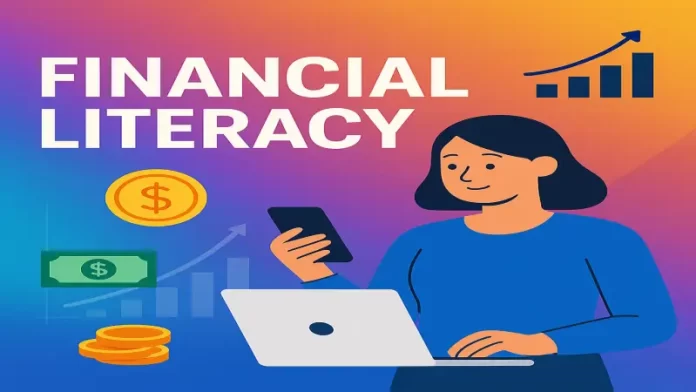If you’re a Millennial or part of Gen Z, navigating the financial world in this year can feel… well, like trying to solve a Rubik’s cube blindfolded while riding a unicycle. Dramatic? Maybe a little. But between student loans, the ever-present lure of lifestyle inflation (thanks, Instagram!), the gig economy shuffle, and just the sheer cost of living these days, especially in buzzing cities like Hyderabad, getting a grip on your finances is less of a ‘nice-to-have’ and more of a ‘survival essential’.
But here’s the good news: understanding money, or achieving financial literacy, isn’t some secret code reserved for Wall Street types. It’s about learning a few key concepts and building habits that put you in the driver’s seat. Ready to level up your money game? Let’s dive in.
Table of Contents
Why is Financial Literacy Such a Big Deal for Us Right Now?
Millennials and Gen Z are facing a unique economic landscape. We’ve navigated recessions, a pandemic, the rise of digital everything, and eye-watering inflation. We’re often juggling student debt longer than previous generations, facing a super competitive job market (hello, side hustles!), and maybe feeling the pressure to maintain a certain lifestyle. Its a lot.
But it’s not all doom and gloom! We also have unprecedented access to information (hello, internet!), powerful fintech apps at our fingertips, and, especially for Gen Z, a long time horizon for investments to grow. The key is harnessing these advantages. Financial literacy empowers you to:
- Make informed decisions (not just guessing).
- Avoid common money traps (like crippling debt).
- Build wealth over time (yes, even on a modest income).
- Reduce financial stress (imagine that!).
- Achieve your goals (whether that’s travel, buying a home, or retiring comfortably someday).

Key Concept #1: Budgeting – Know Thyself (Financially)
Okay, the word budgeting might trigger images of boring spreadsheets and saying ‘no’ to everything fun. Lets reframe that. Budgeting isn’t about restriction; it’s about awareness and control. It’s simply telling your money where to go, instead of wondering where it went. Seriously, where does it all go sometimes?
- Track Your Spending: First step? Figure out your actual spending habits. Use an app, a spreadsheet, or even old-school pen and paper for a month. You might be surprised. There’s many apps available that automates much of this.
- Choose a Method:
- 50/30/20 Rule: A popular starting point. 50% of after-tax income for Needs (rent, utilities, groceries, minimum debt payments), 30% for Wants (dining out, entertainment, hobbies), and 20% for Savings & Debt Repayment (above minimums). Simple, flexible.
- Zero-Based Budgeting: Every single dollar gets assigned a job (spending, saving, investing, debt). More detailed, but very effective for control.
- Be Realistic & Flexible: Your budget isn’t set in stone. Review and adjust it regularly as your income or expenses change. It’s a tool, not a prison.
Key Concept #2: Saving – Pay Your Future Self First
Saving money might seem impossible when you’re just starting out, but it’s fundamental. Even small amounts add up significantly over time, thanks to the magic of compounding (where your savings start earning their own returns).
- Emergency Fund: This is non-negotiable! Aim to save 3-6 months’ worth of essential living expenses in an easily accessible place (like a high-yield savings account or maybe a liquid fund, not invested in volatile assets). This fund is your buffer against unexpected job loss, medical bills, or car trouble. It prevents you from derailing your finances or going into debt when life happens. Seriously, prioritize this.
- Short-Term Goals: Saving for a vacation, a new phone, a down payment on a bike? Set specific, measurable goals and automate your savings towards them each month.
- Long-Term Goals (Yes, Even Retirement!): It might feel lifetimes away, but starting to save for retirement early is the single biggest advantage young adults have. Even small, consistent contributions to things like the 401(k) Plan, Certificates of Deposit (CDs), or mutual fund SIPs can grow massively over decades. Saving consistently make a huge difference down the line.
Key Concept #3: Debt Management – Don’t Let it Own You
Debt isn’t inherently evil, but unmanaged debt can be a major roadblock. Understanding the difference and having a plan is key.
- Good Debt vs. Bad Debt: Generally, ‘good’ debt helps you increase your net worth or future income potential (e.g., affordable student loans for a valuable degree, a mortgage on a property that appreciates). ‘Bad’ debt typically finances depreciating assets or consumption (e.g., high-interest credit card debt for non-essentials, some personal loans).
- Tackle High-Interest Debt: Credit card debt, with its sky-high interest rates, is often financial enemy #1. Always aim to pay more than the minimum payment. Explore strategies like the ‘debt snowball‘ (paying off smallest debts first for psychological wins) or ‘debt avalanche’ (paying off highest-interest debts first to save more money).
- Student Loans: Understand your repayment options (especially for government loans). Explore consolidation or refinancing if it makes sense for your situation. Don’t ignore them! Defaulting have serious consequences.
- Buy Now, Pay Later (BNPL): Services like PayPal Pay in 4, Affirm, or Afterpay are convenient, but can easily lead to overspending if you’re not careful. Track these payments like any other debt.
Key Concept #4: Investing – Grow Your Money Tree
Saving is crucial, but to truly build wealth and beat inflation, you likely need to invest. Investing involves taking on some risk in the hope of achieving higher returns than savings accounts offer. Scary? It doesn’t have to be.
- Start Small & Early: You don’t need a fortune to start. Thanks to platforms and options like Dollar-Cost Averaging (DCA) in mutual funds, you can often start investing with amounts as low as $10 or $1000 per month. The key is consistency and starting early to leverage compounding.
- Understand Basic Options:
- Mutual Funds: Pools money from many investors to buy a diversified portfolio of stocks, bonds, or other assets. Professionally managed. Great for beginners due to built-in diversification. Equity Linked Savings Schemes (ELSS) also offer tax benefits under Section 80C in India, Tax-Advantaged Mutual Funds Some funds are structured to minimize taxable distributions, similar to ELSS,
- Stocks/Equities: Buying shares of individual companies. Higher potential reward, but also higher risk and requires more research. Discount brokers like Charles Schwab – Offers $0 commissions on stocks and ETFs, plus strong research tools, Fidelity Investments, No-fee stock and ETF trades, known for excellent customer service, Webull, Commission-free trading with a user-friendly mobile app, Interactive Brokers (IBKR), Low-cost trading with access to global markets, ETRADE from Morgan Stanley, $0 commissions on U.S.-listed stocks and ETFs, Robinhood, Popular for commission-free trading and fractional shares, Merrill Edge, No commissions on stocks, ETFs, and some mutual funds, TradeStation, Offers commission-free trading with advanced tools, have made this accessible.
- EPF/PPF: Government-backed, long-term savings schemes in India offering relatively safe returns and tax benefits. Excellent for retirement planning.
- Other Assets (Gold, Real Estate, Crypto): These exist too. Gold is a traditional hedge. Real estate requires significant capital. Crypto is highly volatile and speculative approach with extreme caution and only invest what you can afford to lose entirely.
- Risk Tolerance & Diversification: Understand how much risk you’re comfortable with. Don’t put all your eggs in one basket diversify across different asset classes.
Disclaimer: This is for informational purposes only and is not financial advice. Always do your own research (DYOR) or consult with a qualified financial advisor before making investment decisions. The options for investing is varied and complex.
Key Concept #5: Credit Score – Your Financial Reputation
Think of your credit score as a numerical representation of your creditworthiness. Lenders use it to decide whether to approve you for loans (home, car, personal) or credit cards, and at what interest rate. A good score can save you thousands over time.
- What Impacts It? Payment history (paying bills on time is HUGE), credit utilization (how much of your available credit you’re using keep it low, ideally below 30%), length of credit history, credit mix, and new credit inquiries.
- How to Build/Improve It:
- Pay ALL your bills on time, every time. Even utility bills can sometimes impact it.
- Keep credit card balances low.
- Don’t open too many new accounts too quickly.
- Check your credit report regularly for errors (you’re entitled to free reports annually). Its important to dispute any inaccuracies you find.
- A good score is essential for major life goals. Don’t neglect it!
Key Concept #6: Insurance – Your Financial Safety Net
Insurance is about managing risk. You pay a premium to protect yourself against potentially devastating financial losses.
- Health Insurance: Absolutely critical. Medical emergencies can wipe out savings instantly. Understand your coverage (inclusions, exclusions, network hospitals, claim process). Whether through your employer or purchased individually, make sure you have adequate cover. Me and my family prioritize this.
- Term Life Insurance: If you have dependents (spouse, children, parents) who rely on your income, term life insurance provides a payout upon your death to help support them. It’s typically inexpensive when you’re young and healthy.
- Other Insurance: Depending on your assets, you might consider vehicle insurance (mandatory for driving), renters insurance, etc.
Key Concept #7: Taxes – Understand the Basics
Nobody likes taxes, but understanding the basics is crucial for money management young adults need to grasp.
- Income Tax: Understand the tax slabs applicable to your income level.
- Deductions & Exemptions: Learn about common ways to reduce your taxable income legally.
- Filing Returns: File your income tax return (ITR) on time every year, even if your employer deducts TDS (Tax Deducted at Source). It’s a legal requirement and necessary for things like loan applications.
Finding Reliable Info & Dodging Scams
The internet is awash with financial “gurus” and advice. Be critical!
- Seek Reputable Sources: Look for established financial institutions, reputable news outlets, government financial education websites, and qualified, fee-only financial advisors (who don’t earn commissions selling specific products).
- Beware of Red Flags: Be deeply skeptical of anything promising guaranteed high returns, pressure to invest quickly, requests for personal information upfront, or get-rich-quick schemes. If it sounds too good to be true, it almost certainly is. Financial scams targeting young people online are rampant.
Small Steps, Big Future
Phew! That was a lot. But remember, achieving financial literacy isn’t about becoming an expert overnight. It’s about taking consistent, small steps. Start by tracking your spending. Build that emergency fund. Learn about one type of investment. Check your credit score.
Your financial journey is unique to you. Don’t compare yourself to others (especially not their curated social media lives!). Focus on understanding these key concepts, building good habits, and making informed choices. Financial freedom are attainable, and the journey starts now. You got this!

